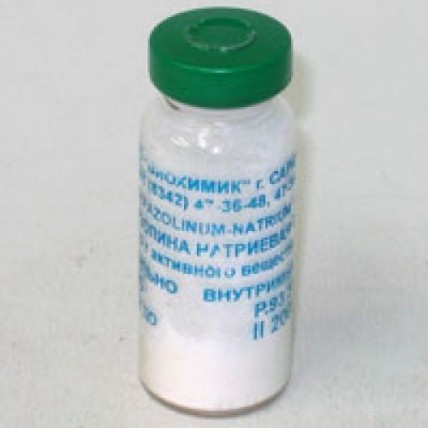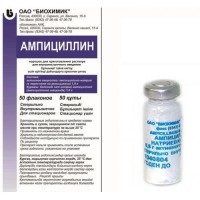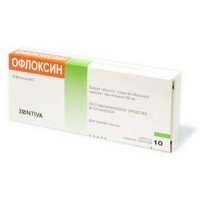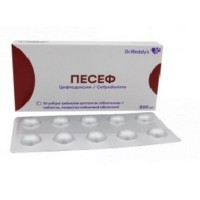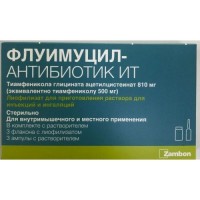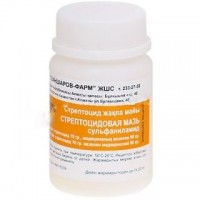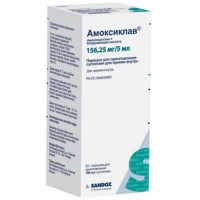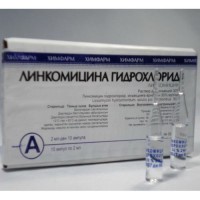Cefazolin sodium salt 1g 1's (50pcs in the armature.) Powder for injection intravenously and intramuscularly
- $2.90
The instruction
for medical use
of CEFAZOLIN medicine
the Trade name
Cefazolin
the International unlicensed
name Cefazolin Dosage Form Powder for preparation of solution for intravenous and intramuscular administration of 1.0 g
Structure
1 bottle of drug contains
active agent of cefazolin sodium (in terms of cefazolin) 1.0 g
the Description
Powder of white or almost white color
Pharmacotherapeutic group:
Antibacterial drugs for system use. Beta laktamnye antibacterial drugs, other. Cephalosporins of the first generation. Cefazolin.
The ATX J01DB04 code
the Pharmacological
Pharmacokinetics At properties oral administration cefazolin is not soaked up. The cefazolin entered
intramusculary or intravenously creates high concentrations in serum.
At intramuscular introduction (in oil), cefazolin is quickly soaked up from the place of an injection. After introduction of concentration in oil to blood higher and remain longer, than after introduction of the majority of other cephalosporins.
After introduction of 0.5 g and 1 g to blood the following peak concentration are reached:
The dose in oil
Time after an injection (in hours) and concentration in blood
(in mkg/ml)
1/2
1.00
2.00
4.00
6.00
8.00
10.00
0.5
32.20 36.80 37.90 15.50 6.30 3.00
-
1 g
60.10 63.80 64.30 29.80 13.20 7.10
& lt, 4.1
Duration of plasma elimination half-life makes about two hours.
After intravenous (in / c) introduction of 1 g of cefazolin the maximum concentration in serum of 188.4 mkg/ml is reached in 5 minutes, decreasing in 4 hours to 16.5 mkg/ml.
About 70-90% of the entered dose contact proteins of plasma.
Cefazolin easily gets into various fabrics and bodies, including into tonsils, a wall of a gall bladder and an appendix. Cefazolin is also found in high concentrations in physiological liquids of an organism. In the absence of obstruction of biliary tract in 4 hours after introduction of its concentration in bile exceed those in serum. Cefazolin reaches therapeutic concentration in ascitic and pleural liquid, inflammatory exudate, lungs, a liver, skin and soft tissues, joints, heart and a peritoneum, a middle ear. Very high concentrations of cefazolin are created in kidneys - after introduction of 1 g of cefazolin its concentration in urine makes up to 4000 mkg/ml. Cefazolin passes through capillary membranes in bones and reaches bactericidal concentration in liquid of interstitial space of the healthy and affected with an osteomelitis bone.
In the absence of an infection of a meninx, cefazolin is found out in cerebrospinal fluid in extremely insignificant concentration therefore it is possible to consider that it does not pass through a blood-brain barrier.
Concentration of cefazolin in a blood-groove of a fruit is similar to that mother in a blood-groove. Cefazolin is found in milk of the feeding women in very low concentration.
Cefazolin is not metabolized in a liver and removed from an organism in not changed look, mainly with urine (due to glomerular filtration and canalicular secretion). The amount of the cefazolin removed with urine is during the first 6 h - 6090%, in 24 h - 7095% of the entered dose. Removal of cefazolin together with bile happens only in insignificant degree.
T1/2 from plasma increases at patients with renal failures to 2040 h.
A pharmacodynamics
the Tsefalosporinovy antibiotic of the I generation for parenteral use. Works bakteritsidno, breaking synthesis of a cell wall of microorganisms. Has a broad spectrum of activity, it is active concerning gram-positive (Staphylococcus spp., Staphylococcus aureus (which are not producing and producing penicillinase), Streptococcus pneumoniae, Corynebacterium diphtheriae, Bacillus anthracis) and gram-negative (Neisseria meningitidis, Neisseria gonorrhoeae, Shigella spp., Salmonella spp., Escherichia coli, Klebsiella spp., Treponema spp., Leptospira spp.) microorganisms. It is active concerning Haemophilus influenzae, some strains of Enterobacter spp. and Enterococcus spp.
It is inefficient concerning Pseudomonas aeruginosa, indolpositive strains of Proteus spp., Mycobacterium tuberculosis, Serratia spp., anaerobic microorganisms, metitsillinustoychivy strains of Staphylococcus spp.
Indications
- respiratory infections
- infections of urinary tract
- infections of skin and soft tissues
- infections of biliary tract
- infections of bones and joints
- gynecologic infections
- a septicaemia
- an endocarditis
- prevention of infections at surgical interventions
Establish the Route of administration and doses individually, taking into account weight of a course and an infection, sensitivity of the activator.
To administer the drug intramusculary (in oil) or intravenously (in / c) struyno or by drop infusion. The drug cannot be administered in a cavity of a spinal canal. The period of intramuscular therapy has to be so short as far as it is possible. The solutions prepared for intramuscular injections should not be used for intravenous administration. For introduction in oil drug is previously dissolved in 2-3 ml of water for injections or 0.25-0.5 ml of 5% of solution of novocaine. Lidocaine is not used as solvent in pediatric practice. For in/in jet the introductions part a single dose in 10 ml of isotonic solution of sodium of chloride. Enter slowly within 3-5 min. At intravenous drop administration of 0.5-1.0 g of drug previously part in 100-250 ml of isotonic solution of sodium of chloride. Frequency rate of introduction of 6 - 8 times a day. The maximum daily dose - 6 g.
The average daily dose for children with body weight higher than 4.5 kg makes 25-50 mg/kg of body weight, at a heavy course of an infection the dose can be increased up to 100 mg/kg a day.
Duration of treatment is 7-10 days.
For prevention of postoperative infectious complications appoint 1 g of cefazolin in 30 min. prior to operation, 0.5-1g during operation, the 05-1st each 4 - 6 hours within a day after operation.
With care apply in a renal failure. Patients can appoint cefazolin with reduced function of kidneys with the following corrections of a dose: patients with clearance of creatinine of 55 ml/min. or it is more or with creatinine of serum of 1.5 mg of % or can receive full doses less. Patients with a speed of clearance of creatinine from 35 to 54 ml/min. or creatinine of serum of 1,6 3,0 mg of % can also receive full doses, but introduction needs to be limited to the minimum intervals between introduction at 8 o'clock. Patients with a speed of clearance of creatinine from 11 to 34 ml/min. or creatinine of serum of 3,1 4,5 mg of % receive a half of a usual dose each 12 hours. Patients with a speed of clearance of creatinine of 10 ml/min. or it is less or creatinine of serum of 4.6 mg of % or receive a half of a usual dose of each 18 24 hour above. Recommendations about dose adjustment are applicable after an initial shock dose, the corresponding weight of an infection.
To children with a renal failure from easy to moderate degree (clearance of creatinine from 70 to 40 ml/min.) appoint 60 percent of the normal daily dose entered similarly by the divided doses each 12 hours. In a moderate renal failure (clearance of creatinine from 40 to 20 ml/min.), 25 percent of the usual daily dose entered similarly by the divided doses each 12 hours. Children with a heavy renal failure (clearance of creatinine from 20 to 5 ml/min.) can appoint 10 percent of a normal daily dose each 24 hours.
Side effects
- nausea, heartburn, vomiting, diarrhea, an abdominal pain
- a headache, dizziness
- interstitial pneumonia or a syndrome of PIE (pulmonary infiltrate with an eosinophilia)
- a mucous and skin and eye syndrome (Stephens's syndrome of Johnson), a toxic epidermal necrolysis (Lyell's disease)
- tranzitorny increase in activity of hepatic transaminases
- urticaria, a skin itching, fever, a Quincke's edema, an acute anaphylaxis
- arthralgias, spasms
- candidiasis, pseudomembranous colitis
- the reversible leukopenia, a granulocytopenia, an eosinophilia, a neutropenia, an agranulocytosis, hemolytic anemia or thrombocytopenia, deficiency of vitamin K, deficiency of vitamin B
- a renal failure, a heavy renal failure, increase in creatinine in blood
- is possible morbidity in the place of an intramuscular injection
Seldom
- cholestatic jaundice
-
the Contraindication hypoglycemia
- hypersensitivity to drugs of group tsefalosporinovy and others - laktamny antibiotics (including both penicillin and karbapenema)
- the neonatality period (up to 1 month), prematurity
- is not recommended a concomitant use with anticoagulants and diuretics
- heart block
- pregnancy and the period of a lactation
With care
- a renal failure
- intestines diseases (including colitis in the anamnesis)
- children's age from 1 to 12 months.
Cefazolin along with anticoagulants is not recommended to appoint medicinal interactions.
At simultaneous use to loopback diuretics (furosemide, Acidum etacrynicum) there is a blockade of canalicular secretion of cefazolin (it is necessary to avoid combined use).
The renal clearance of cefazolin decreases at a concomitant use of a probenetsid that results in the increased and more long concentration of cefazolin in blood.
Synergism of antibacterial action at a combination with aminoglikozidny antibiotics, Vancomycinum, rifampicin is noted. Aminoglycosides increase risk of development of damage of kidneys. Pharmaceutical it is incompatible with aminoglycosides (mutual inactivation).
Cefazolin, suppressing indestinal flora, interferes with vitamin K synthesis. Therefore at simultaneous use with the drugs reducing aggregation of thrombocytes (nonsteroid protivospalitelny drugs (NPVP), salicylates) the risk of developing bleedings increases. For the same reason at simultaneous use with anticoagulants strengthening of anticoagulating action is noted. It is not necessary to apply cefazolin together with the antibakteralny drugs having the bacteriostatic mechanism of action (tetracyclines, streptocides, erythromycin, chloramphenicol) as the researches in vitro showed that between them there is an antagonism.
Cefazolin can cause Disulfiramum - similar reactions at simultaneous use with ethanol.
Special instructions
Before purpose of therapy with use of Cefazolin it is necessary to conduct careful survey to define whether arose at the patient before reaction of hypersensitivity to cefazolin, cephalosporins, penicillin or other medicines. It is necessary to show care at administration of Cefazolin to patients with earlier shown hypersensitivity to penicillin as concerning 10% of patients with earlier arising episodes of an allergy to penicillin cases of a cross allergy between a beta laktamnymi antibiotics and development of reaction of hypersensitivity were noted. Therapy with use of Cefazolin needs to be stopped if allergic reaction is observed.
Treatment needs to be stopped at emergence of any side effects.
It is necessary to show care when prescribing drug:
- to patients with bronchial asthma, rashes or episodes of a small tortoiseshell in the anamnesis,
a heavy renal failure,
- in cases of insufficiency or disturbance of food, when carrying out parenteral nutrition or to patients with the significant loss of forces (these patients can suffer from deficiency of vitamin K, they need to carry out careful monitoring),
- to elderly patients.
It was reported that honor all antibiotic means, including Cefazolin, can cause pseudomembranous colitis. Therefore, potential risk of developing pseudomembranous colitis needs to be considered in case of patients who have a diarrhea in time or after antibacterial treatment.
Cephalosporins can cause decrease in prothrombin activity. Patients with a renal or liver failure or the bad alimentary status and also the patients taking a long course of antibacterial therapy and the patients who were earlier stabilized on anticoagulating therapy enter into risk group. It is necessary to watch a prothrombin time at patients of risk group. Exogenous vitamin K needs to be entered as directed.
Cefazolin contains sodium. This fact needs to be taken into account in case of patients on a controlled sodium diet.
Though drug can be the cause of obtaining in a false manner positive takes when determining glucose in urine during the researches conducted with Benedict's reactants, Felinga or Klinitest, it would not yield in a false manner positive takes when using an enzymatic test method.
Use of drug can lead to obtaining in a false manner positive takes of the direct or indirect antiglobulinovy test (Koombs's test). At newborns whose mothers were treated by cephalosporins till the child's birth, positive takes of test of Koombs can be received in a false manner.
With care to use to patients of senile age and to pay special attention to doses and intervals between introduction of doses. Due to the reduced physiological functions the elderly patients, have a probability of emergence of the undesirable phenomena (for example, bleeding, owing to deficiency of vitamin K).
Because safety of use at premature children and newborns was not established, use of drug for these patients is not recommended.
Features of influence of medicine on ability to run
motor transport or moving mechanisms
Considering side effects of drug, it is necessary to be careful at control of motor transport or moving mechanisms.
Overdose
Symptoms: pain, inflammatory reactions in the injection site, dizziness, a headache, paresthesias, is possible development of spasms (especially at patients with diseases of kidneys), the increased concentration of creatinine, urea nitrogen of blood, enzymes of a liver and bilirubin, false positive reaction of Koombs, a thrombocytosis and thrombocytopenia, an eosinophilia, a leukopenia and also increase in a prothrombin time
Treatment: immediate termination of administration of drug, control of the vital functions of an organism and corresponding laboratory indicators, symptomatic therapy. In hard cases carrying out a hemodialysis is possible. Peritoneal dialysis is not effective.
A form of release and packing
of 1.0 g of active agent in bottles from a tube glass, hermetically corked by the rubber bungs which are pressed out by caps aluminum. 50 bottles stack in a box of cardboard with an investment from 3 to 5 instructions for medical use of drug on state and Russian and languages (for hospitals).
To Store storage conditions in the dry, protected from light place at
a temperature not higher than 25 S. Hranit out of children's reach!
A period of storage
2 years
not to use after an expiration date
Prescription status
According to the prescription
JSC Biokhimik Producer, the Russian Federation, 430030, Saransk, st. Vasenko, 15 A
Ph./fax (8342) 47-36-48, 47-36-78.
The name and the country of the owner of the registration certificate
of JSC Biokhimik, the Russian Federation
the Address of the organization accepting in the territory of the Republic of Kazakhstan claims from consumers on quality of products (goods):
TsentrAziyaFarm LLP,
050030, Republic of Kazakhstan Almaty, Krasnogvardeysky path, 258 V
ph. 727 232 90 50, 727 385 04 00, e-mail:
To develop register@caph.kz
for medical use
of CEFAZOLIN medicine
the Trade name
Cefazolin
the International unlicensed
name Cefazolin Dosage Form Powder for preparation of solution for intravenous and intramuscular administration of 1.0 g
Structure
1 bottle of drug contains
active agent of cefazolin sodium (in terms of cefazolin) 1.0 g
the Description
Powder of white or almost white color
Pharmacotherapeutic group:
Antibacterial drugs for system use. Beta laktamnye antibacterial drugs, other. Cephalosporins of the first generation. Cefazolin.
The ATX J01DB04 code
the Pharmacological
Pharmacokinetics At properties oral administration cefazolin is not soaked up. The cefazolin entered
intramusculary or intravenously creates high concentrations in serum.
At intramuscular introduction (in oil), cefazolin is quickly soaked up from the place of an injection. After introduction of concentration in oil to blood higher and remain longer, than after introduction of the majority of other cephalosporins.
After introduction of 0.5 g and 1 g to blood the following peak concentration are reached:
The dose in oil
Time after an injection (in hours) and concentration in blood
(in mkg/ml)
1/2
1.00
2.00
4.00
6.00
8.00
10.00
0.5
32.20 36.80 37.90 15.50 6.30 3.00
-
1 g
60.10 63.80 64.30 29.80 13.20 7.10
& lt, 4.1
Duration of plasma elimination half-life makes about two hours.
After intravenous (in / c) introduction of 1 g of cefazolin the maximum concentration in serum of 188.4 mkg/ml is reached in 5 minutes, decreasing in 4 hours to 16.5 mkg/ml.
About 70-90% of the entered dose contact proteins of plasma.
Cefazolin easily gets into various fabrics and bodies, including into tonsils, a wall of a gall bladder and an appendix. Cefazolin is also found in high concentrations in physiological liquids of an organism. In the absence of obstruction of biliary tract in 4 hours after introduction of its concentration in bile exceed those in serum. Cefazolin reaches therapeutic concentration in ascitic and pleural liquid, inflammatory exudate, lungs, a liver, skin and soft tissues, joints, heart and a peritoneum, a middle ear. Very high concentrations of cefazolin are created in kidneys - after introduction of 1 g of cefazolin its concentration in urine makes up to 4000 mkg/ml. Cefazolin passes through capillary membranes in bones and reaches bactericidal concentration in liquid of interstitial space of the healthy and affected with an osteomelitis bone.
In the absence of an infection of a meninx, cefazolin is found out in cerebrospinal fluid in extremely insignificant concentration therefore it is possible to consider that it does not pass through a blood-brain barrier.
Concentration of cefazolin in a blood-groove of a fruit is similar to that mother in a blood-groove. Cefazolin is found in milk of the feeding women in very low concentration.
Cefazolin is not metabolized in a liver and removed from an organism in not changed look, mainly with urine (due to glomerular filtration and canalicular secretion). The amount of the cefazolin removed with urine is during the first 6 h - 6090%, in 24 h - 7095% of the entered dose. Removal of cefazolin together with bile happens only in insignificant degree.
T1/2 from plasma increases at patients with renal failures to 2040 h.
A pharmacodynamics
the Tsefalosporinovy antibiotic of the I generation for parenteral use. Works bakteritsidno, breaking synthesis of a cell wall of microorganisms. Has a broad spectrum of activity, it is active concerning gram-positive (Staphylococcus spp., Staphylococcus aureus (which are not producing and producing penicillinase), Streptococcus pneumoniae, Corynebacterium diphtheriae, Bacillus anthracis) and gram-negative (Neisseria meningitidis, Neisseria gonorrhoeae, Shigella spp., Salmonella spp., Escherichia coli, Klebsiella spp., Treponema spp., Leptospira spp.) microorganisms. It is active concerning Haemophilus influenzae, some strains of Enterobacter spp. and Enterococcus spp.
It is inefficient concerning Pseudomonas aeruginosa, indolpositive strains of Proteus spp., Mycobacterium tuberculosis, Serratia spp., anaerobic microorganisms, metitsillinustoychivy strains of Staphylococcus spp.
Indications
- respiratory infections
- infections of urinary tract
- infections of skin and soft tissues
- infections of biliary tract
- infections of bones and joints
- gynecologic infections
- a septicaemia
- an endocarditis
- prevention of infections at surgical interventions
Establish the Route of administration and doses individually, taking into account weight of a course and an infection, sensitivity of the activator.
To administer the drug intramusculary (in oil) or intravenously (in / c) struyno or by drop infusion. The drug cannot be administered in a cavity of a spinal canal. The period of intramuscular therapy has to be so short as far as it is possible. The solutions prepared for intramuscular injections should not be used for intravenous administration. For introduction in oil drug is previously dissolved in 2-3 ml of water for injections or 0.25-0.5 ml of 5% of solution of novocaine. Lidocaine is not used as solvent in pediatric practice. For in/in jet the introductions part a single dose in 10 ml of isotonic solution of sodium of chloride. Enter slowly within 3-5 min. At intravenous drop administration of 0.5-1.0 g of drug previously part in 100-250 ml of isotonic solution of sodium of chloride. Frequency rate of introduction of 6 - 8 times a day. The maximum daily dose - 6 g.
The average daily dose for children with body weight higher than 4.5 kg makes 25-50 mg/kg of body weight, at a heavy course of an infection the dose can be increased up to 100 mg/kg a day.
Duration of treatment is 7-10 days.
For prevention of postoperative infectious complications appoint 1 g of cefazolin in 30 min. prior to operation, 0.5-1g during operation, the 05-1st each 4 - 6 hours within a day after operation.
With care apply in a renal failure. Patients can appoint cefazolin with reduced function of kidneys with the following corrections of a dose: patients with clearance of creatinine of 55 ml/min. or it is more or with creatinine of serum of 1.5 mg of % or can receive full doses less. Patients with a speed of clearance of creatinine from 35 to 54 ml/min. or creatinine of serum of 1,6 3,0 mg of % can also receive full doses, but introduction needs to be limited to the minimum intervals between introduction at 8 o'clock. Patients with a speed of clearance of creatinine from 11 to 34 ml/min. or creatinine of serum of 3,1 4,5 mg of % receive a half of a usual dose each 12 hours. Patients with a speed of clearance of creatinine of 10 ml/min. or it is less or creatinine of serum of 4.6 mg of % or receive a half of a usual dose of each 18 24 hour above. Recommendations about dose adjustment are applicable after an initial shock dose, the corresponding weight of an infection.
To children with a renal failure from easy to moderate degree (clearance of creatinine from 70 to 40 ml/min.) appoint 60 percent of the normal daily dose entered similarly by the divided doses each 12 hours. In a moderate renal failure (clearance of creatinine from 40 to 20 ml/min.), 25 percent of the usual daily dose entered similarly by the divided doses each 12 hours. Children with a heavy renal failure (clearance of creatinine from 20 to 5 ml/min.) can appoint 10 percent of a normal daily dose each 24 hours.
Side effects
- nausea, heartburn, vomiting, diarrhea, an abdominal pain
- a headache, dizziness
- interstitial pneumonia or a syndrome of PIE (pulmonary infiltrate with an eosinophilia)
- a mucous and skin and eye syndrome (Stephens's syndrome of Johnson), a toxic epidermal necrolysis (Lyell's disease)
- tranzitorny increase in activity of hepatic transaminases
- urticaria, a skin itching, fever, a Quincke's edema, an acute anaphylaxis
- arthralgias, spasms
- candidiasis, pseudomembranous colitis
- the reversible leukopenia, a granulocytopenia, an eosinophilia, a neutropenia, an agranulocytosis, hemolytic anemia or thrombocytopenia, deficiency of vitamin K, deficiency of vitamin B
- a renal failure, a heavy renal failure, increase in creatinine in blood
- is possible morbidity in the place of an intramuscular injection
Seldom
- cholestatic jaundice
-
the Contraindication hypoglycemia
- hypersensitivity to drugs of group tsefalosporinovy and others - laktamny antibiotics (including both penicillin and karbapenema)
- the neonatality period (up to 1 month), prematurity
- is not recommended a concomitant use with anticoagulants and diuretics
- heart block
- pregnancy and the period of a lactation
With care
- a renal failure
- intestines diseases (including colitis in the anamnesis)
- children's age from 1 to 12 months.
Cefazolin along with anticoagulants is not recommended to appoint medicinal interactions.
At simultaneous use to loopback diuretics (furosemide, Acidum etacrynicum) there is a blockade of canalicular secretion of cefazolin (it is necessary to avoid combined use).
The renal clearance of cefazolin decreases at a concomitant use of a probenetsid that results in the increased and more long concentration of cefazolin in blood.
Synergism of antibacterial action at a combination with aminoglikozidny antibiotics, Vancomycinum, rifampicin is noted. Aminoglycosides increase risk of development of damage of kidneys. Pharmaceutical it is incompatible with aminoglycosides (mutual inactivation).
Cefazolin, suppressing indestinal flora, interferes with vitamin K synthesis. Therefore at simultaneous use with the drugs reducing aggregation of thrombocytes (nonsteroid protivospalitelny drugs (NPVP), salicylates) the risk of developing bleedings increases. For the same reason at simultaneous use with anticoagulants strengthening of anticoagulating action is noted. It is not necessary to apply cefazolin together with the antibakteralny drugs having the bacteriostatic mechanism of action (tetracyclines, streptocides, erythromycin, chloramphenicol) as the researches in vitro showed that between them there is an antagonism.
Cefazolin can cause Disulfiramum - similar reactions at simultaneous use with ethanol.
Special instructions
Before purpose of therapy with use of Cefazolin it is necessary to conduct careful survey to define whether arose at the patient before reaction of hypersensitivity to cefazolin, cephalosporins, penicillin or other medicines. It is necessary to show care at administration of Cefazolin to patients with earlier shown hypersensitivity to penicillin as concerning 10% of patients with earlier arising episodes of an allergy to penicillin cases of a cross allergy between a beta laktamnymi antibiotics and development of reaction of hypersensitivity were noted. Therapy with use of Cefazolin needs to be stopped if allergic reaction is observed.
Treatment needs to be stopped at emergence of any side effects.
It is necessary to show care when prescribing drug:
- to patients with bronchial asthma, rashes or episodes of a small tortoiseshell in the anamnesis,
a heavy renal failure,
- in cases of insufficiency or disturbance of food, when carrying out parenteral nutrition or to patients with the significant loss of forces (these patients can suffer from deficiency of vitamin K, they need to carry out careful monitoring),
- to elderly patients.
It was reported that honor all antibiotic means, including Cefazolin, can cause pseudomembranous colitis. Therefore, potential risk of developing pseudomembranous colitis needs to be considered in case of patients who have a diarrhea in time or after antibacterial treatment.
Cephalosporins can cause decrease in prothrombin activity. Patients with a renal or liver failure or the bad alimentary status and also the patients taking a long course of antibacterial therapy and the patients who were earlier stabilized on anticoagulating therapy enter into risk group. It is necessary to watch a prothrombin time at patients of risk group. Exogenous vitamin K needs to be entered as directed.
Cefazolin contains sodium. This fact needs to be taken into account in case of patients on a controlled sodium diet.
Though drug can be the cause of obtaining in a false manner positive takes when determining glucose in urine during the researches conducted with Benedict's reactants, Felinga or Klinitest, it would not yield in a false manner positive takes when using an enzymatic test method.
Use of drug can lead to obtaining in a false manner positive takes of the direct or indirect antiglobulinovy test (Koombs's test). At newborns whose mothers were treated by cephalosporins till the child's birth, positive takes of test of Koombs can be received in a false manner.
With care to use to patients of senile age and to pay special attention to doses and intervals between introduction of doses. Due to the reduced physiological functions the elderly patients, have a probability of emergence of the undesirable phenomena (for example, bleeding, owing to deficiency of vitamin K).
Because safety of use at premature children and newborns was not established, use of drug for these patients is not recommended.
Features of influence of medicine on ability to run
motor transport or moving mechanisms
Considering side effects of drug, it is necessary to be careful at control of motor transport or moving mechanisms.
Overdose
Symptoms: pain, inflammatory reactions in the injection site, dizziness, a headache, paresthesias, is possible development of spasms (especially at patients with diseases of kidneys), the increased concentration of creatinine, urea nitrogen of blood, enzymes of a liver and bilirubin, false positive reaction of Koombs, a thrombocytosis and thrombocytopenia, an eosinophilia, a leukopenia and also increase in a prothrombin time
Treatment: immediate termination of administration of drug, control of the vital functions of an organism and corresponding laboratory indicators, symptomatic therapy. In hard cases carrying out a hemodialysis is possible. Peritoneal dialysis is not effective.
A form of release and packing
of 1.0 g of active agent in bottles from a tube glass, hermetically corked by the rubber bungs which are pressed out by caps aluminum. 50 bottles stack in a box of cardboard with an investment from 3 to 5 instructions for medical use of drug on state and Russian and languages (for hospitals).
To Store storage conditions in the dry, protected from light place at
a temperature not higher than 25 S. Hranit out of children's reach!
A period of storage
2 years
not to use after an expiration date
Prescription status
According to the prescription
JSC Biokhimik Producer, the Russian Federation, 430030, Saransk, st. Vasenko, 15 A
Ph./fax (8342) 47-36-48, 47-36-78.
The name and the country of the owner of the registration certificate
of JSC Biokhimik, the Russian Federation
the Address of the organization accepting in the territory of the Republic of Kazakhstan claims from consumers on quality of products (goods):
TsentrAziyaFarm LLP,
050030, Republic of Kazakhstan Almaty, Krasnogvardeysky path, 258 V
ph. 727 232 90 50, 727 385 04 00, e-mail:
To develop register@caph.kz
